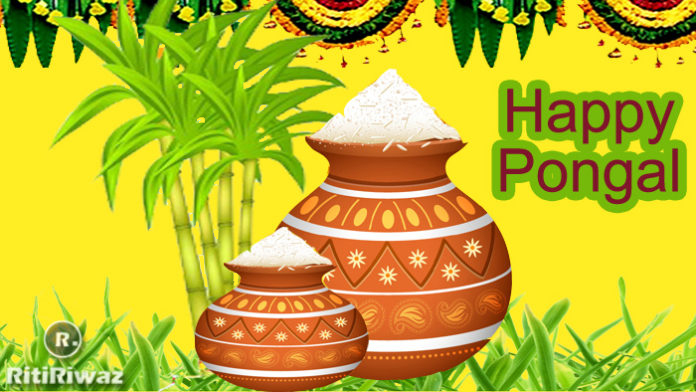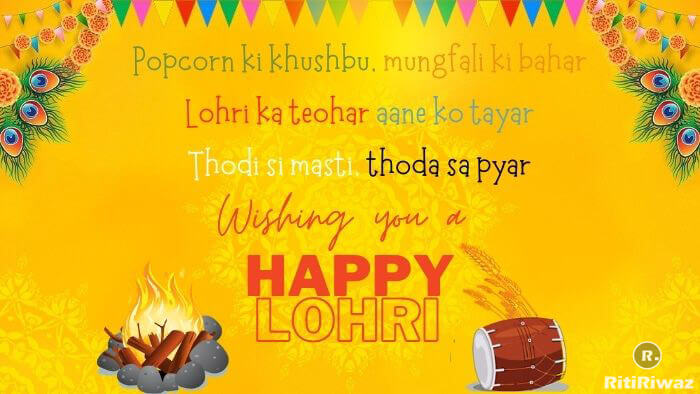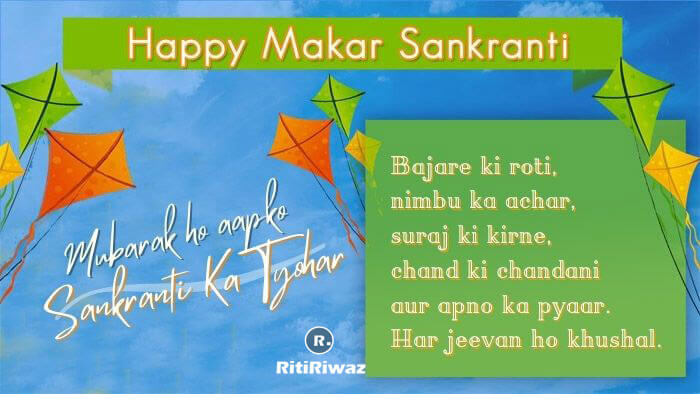Santhali Language
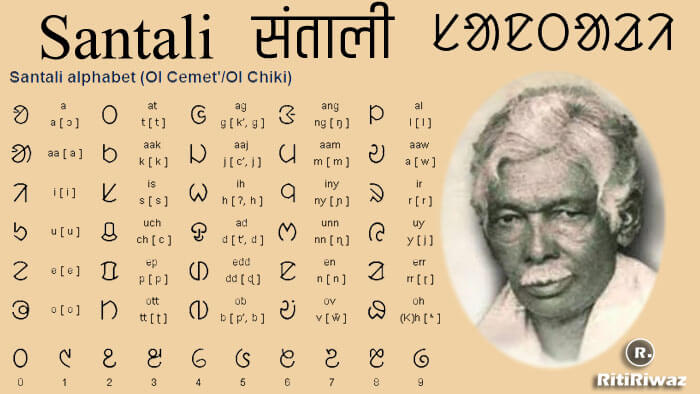
Santhali is also known as the Santali language is spoken by the North Mundari Group of the Austroasiatic-Munda family. The language is spoken in the Indian states of Assam, Bihar, Jharkhand, Mizoram, Odisha, Tripura, and West Bengal, and also in Nepal, Bhutan, and Bangladesh. Santhali language was included in Schedule 8 of the constitution through the 92nd Constitutional Amendment act, 2003. Along with Santhali Maithili, Bodo, Dori language was also included.
The Eighth Schedule to the Constitution consists of the following 22 languages:- (1) Assamese, (2) Bengali, (3) Gujarati, (4) Hindi, (5) Kannada, (6) Kashmiri, (7) Konkani, (8) Malayalam, (9) Manipuri, (10) Marathi, (11) Nepali, (12) Oriya, (13) Punjabi, (14) Sanskrit, (15) Sindhi, (16) Tamil, (17) Telugu, (18) Urdu (19) Bodo, (20) Santhali, (21) Maithili and (22) Dogri. The Sindhi language was added in 1967. Thereafter three more languages viz., Konkani, Manipuri, and Nepali were included in 1992. Subsequently, Bodo, Dogri, Maithili, and Santhali were added in 2004.
The language has reached a much higher stage of development than any other language or dialect of the family to which it belongs. The Santals are the third-largest group in India, described as Scheduled Tribes in the states of Jharkhand, Odisha, and West Bengal but not in Assam. Shikha Mandi, a radio jockey, became India’s first to host a show in the language in November 2017.
History
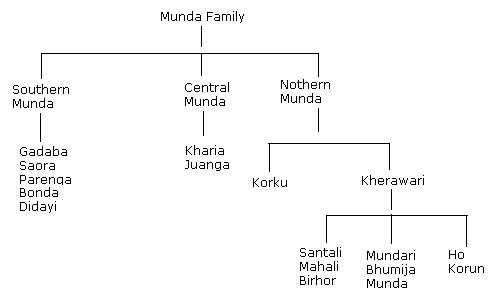
Until the nineteenth century, Santali does not possess an alphabet of its own, the Roman character has been adapted to it as Europeans were interested in studying the languages of India. Devoid of a script of its own the Santali language has been handed down generation after generation orally. However, the first written forms of Santali can be found in the Roman script, written by the Christian missionaries.
However, the Bangla script was used for Santali education, and also Ol Chiki script is used for writing in Santali, which is an Austroasiatic language in 1925 and was first publicized in 1939. Olchiki as Santali Script is widely accepted among Santal Communities, however presently in West Bengal, Odisha & Jharkhand, the Ol Chiki is the official script for Santali literature & language.
Variation of Santali
Northern Santali is spoken in Bhagalpur, Monghyr, the Santal Parganas, Birbhum, Bankura, Hazaribagh, and Manbhum, which is the language of an overwhelming majority of the tribe and is more polished, than Southern Santali. The former is, therefore regarded as the Standard, and Southern Santali, or that is spoken in the remaining districts, as a dialect, or, possibly, a group of dialects of it.
Dialects of Santali include Kamari-Santali, Karmali (Khole), Lohari-Santali, Mahali, Manjhi, Paharia.
There have been slight dialect differences between the Santali if Bihari and the Santali if Bengali districts. Words with the short inherent vowel, adopted Santali of Bihari, retain the short a sound, those adopted from Bengali retain the short o sound. This dialect difference accounts for the different ways of spelling the same word which often occurs.
Invention os Ol Chiki Script for Santali Language
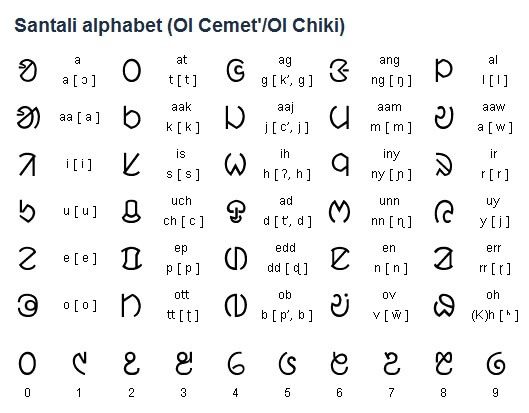
In earlier times, all Santali writings were in Bengali, Devanagari, or Roman script. Although there has been an impressive number of works by foreigner and non-Santal writers on the dictionary, grammar, collection of folklore, etc., these works are mostly intended for research purposes. The Roman script was in extensive use for writing Santali and several books in Santali have been published using the Roman script. But most of the creative literature was written by the native speakers in Bengali or Devanagari script. The use of different scripts for writing Santali has hindered the development and utilization of the Santali language. This, in turn, has effectively marred the progress of the Santali language in several fields such as philosophy, history, religion, science, novel, prose, poetry, etc. The problem of using different scripts for the same language necessitated the invention of a new script for Santali, and it finally led to the invention of Ol Chiki by Pandit Raghunath Murmu. Pt. Murmu is revered by tribals and is recognized as a big cultural icon in the state. Santhali, written in the Ol Chiki script currently has a content of about 70,000 words.
Santali language Phonology
Santali language contains some phonetics which are generally not used in English and neighboring Indian languages, and hence, learning the correct pronunciations of Ol Chiki letters is very important. In fact, these pronunciations give a feeling of why the Santali language needs a separate script, especially the pronunciations of unreleased stops/ k’, c’, t’, p’ /, which are not found in English and other Indic languages. It is a momentary obstruction of the passage of air by the glottis and its sudden release, which creates a small explosion of air, giving the consonant a hard sound. Another notable feature of the Santali language is the presence of voiced and voiceless /h/. The voiceless /h/ occurs frequently in the Santali language. The occurrence of nasals is also extremely regular and they have phonological distinctions in even word-final position.
The Santali phonemic system includes a series of retroflex consonants, voiced and voiceless aspirated stops, and glottalized stops in word-final position, alternating with the voiced series. Some harmony rules underly the vocalism.
Nouns can be marked for number (singular, dual, plural), class (±animate), case (seven in number), possessor, and focus or topic. The demonstrative system has four dimensions: distance (near/far / far away), ±emphatic,±animate, and number.
Santali has a very elaborate verb morphology. Besides various types of argument marking (subject, object, concerned object) the verb is inflected for seven TAM categories the markers of which have two shapes, one for active and one for middle voice. In addition, several derivational processes apply to the stem, such as the marking of reciprocal or intensive. Verbs in series are very common.
Santali is known to have a weak distinction between nouns and verbs, many stems are used both in argument and predicate function. The analysis is mainly based on data collected by Bidding, especially on his text collection (published in 1925) and on his huge dictionary (1929-36). Critical portions of the grammar have been discussed with a native speaker.
Santali in Rajya Sabha
On December 6, 2019, MP Sarojni Hembram from Odisha for the first time spoke in a tribal language called Santhali. She raised the matter of public importance during the zero hours. Also, Srimati Sarojini demanded Bharat Ratna for Pundit Raghunath Murmu, the Santhali scholar who introduced Ol Chiki script for the language in 1925.
Suggested Read: Assamese language




